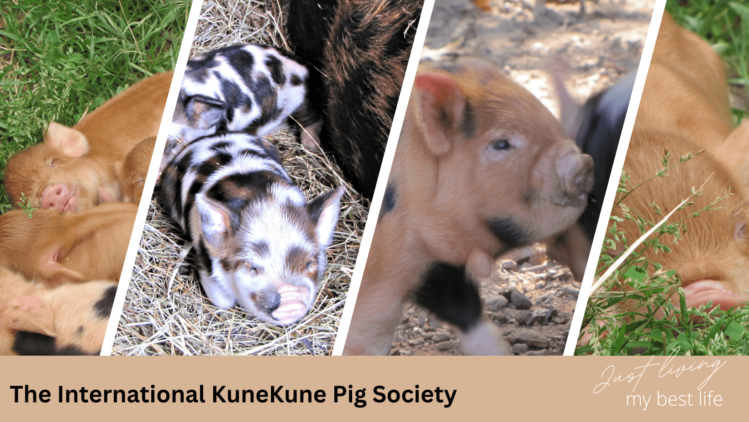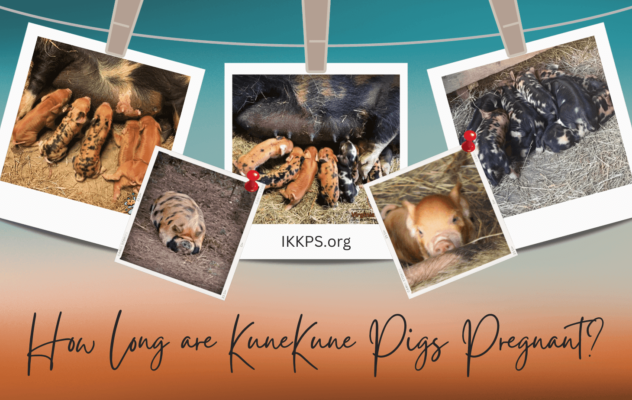
Sign Up
Want to receive a newsletter to learn more about KuneKune pigs and other educational information? Sign up to have them delivered right to your inbox.
We look forwarded to sending you some great info.
Breeding KuneKune Pigs
Breeding KuneKune pigs is a rewarding experience to be enjoyed by the whole family. Find answers to your questions. What age do KuneKune pigs breed? How long are KuneKune pigs pregnant? This page is dedicated to Breeding KuneKunes. Get the answers to your questions and learn more about important topics like how long are KuneKune pigs pregnant?
See also our related article on Breeding & Farrowing.
The Ultimate Guide to Breeding KuneKune Pigs
This guide provides valuable information and tips for breeding KuneKune pigs, what age do KuneKune pigs breed, how long are KuneKune pigs pregnant, and more. Being a rare breed of pig originally from New Zealand. Breeding KuneKune Pigs is a complex process that requires careful planning and paying attention to detail. It is essential to consider the age, health, genetics, and environment of your pigs before breeding them. Proper breeding techniques and pregnancy management are also critical to ensuring the well-being of both the sow and the litter.

Raising these amazing little creatures is such a fun and rewarding experience. This page is dedicated to KuneKune Breeding so that we can help you prepare for all the phases of breeding KuneKune pigs from picking your pair to where to keep the pregnant female. We got you covered. We answer important questions like what age do KuneKune pigs breed and how long are kunekune pigs pregnant. Don't forget to see the section at the end of frequently asked questions.
Introduction
Breeding KuneKunes, a rare breed of pig originally from New Zealand, requires careful planning and attention to detail. From selecting the right breeding pair to managing the pregnancy and birth, there are many factors to consider. This guide provides valuable information and tips for breeders of all levels who are interested in raising these unique and beloved animals.
In this article, we will cover a frequently asked question we hear a lot. When is the right time to breed KuneKune Pigs? How long are KuneKune pigs pregnant? As a slower to mature breed, the wait for breeding age is just a bit more than some other breeds of swine. However, it will be so worth the wait. Breeding KuneKunes too early can have disastrous effects.
Understanding the KuneKune Breed.
Before embarking on the journey of breeding KuneKunes, it is important to have a thorough understanding of the breed. KuneKunes are a small, friendly breed of
pigs that are known for their docile nature and unique appearance. They have a distinctive short snout and tassels, called wattles, under their jowl or chin as some say, and come in a variety of colors and patterns. KuneKunes are also known for their ability to graze and thrive on pasture with only lesser amounts of grain, making them a popular choice for small-scale farmers and homesteaders.
We have a ton of information on managing your herd, feeding 101, and more information on the general care page of our website. Hopefully, you will be knowledgeable about the breed by the time you are ready to breed.
When is the Right Age to Breed Kunekune Pigs?
This is a popular question: What age do KuneKunes breed? Breeding Kunekune pigs can be a rewarding experience for any pig farmer. It also is a learning experience for the whole family. As a result, in raising any type of livestock it will teach children about life and death and even the miracle of birth. However, it is important to ensure that the process is done at the right time to ensure healthy offspring. In this article, we will take you through everything you need to know about Kunekune pig breeding. From understanding their sexual maturity to the factors, you should consider before breeding them, we have you covered. We will also discuss the ideal age for Kunekune pig breeding and some of the techniques used in breeding them. Lastly, we will share some tips on how to manage Kunekune pig pregnancies for a successful outcome. Read on to learn more!

Kune kune pig breeding basics.
As with all animals, timing is crucial when it comes to Kunekune pig breeding. Allowing them to develop properly and ensuring a successful breeding outcome. It is also
essential to consider the health and genetic background of the pigs involved in breeding. Likewise, it is important to evaluate the breed standards and deem
the gilt or sows worthy of breeding first. Proper care and attention during gestation and farrowing can help prevent complications and ensure healthy piglets. By following these basic guidelines, you can successfully breed Kunekune pigs and maintain their reproductive health for years to come.
Understanding sexual maturity in Kunekune pigs.
Introducing Kunekune pigs to your farm is an exciting venture and breeding them is one of the most rewarding aspects of pig farming. However, breeding too early or too late can lead to health complications and reduced fertility in Kunekune pigs Therefore, it is essential to understand the sexual maturity age of these pigs before beginning the breeding process. This is one of the most popular questions: What age do KuneKune pigs breed?
While boars can breed at any age, it is recommended to wait until they are at least a year old for better-quality semen. They typically reach sexual maturity around 8 months of age.
Female KuneKunes
Sexual maturity in female KuneKune pigs typically occurs around 12-14 months of age. Important to note, that the female can start to go in heat as early as 7-8 months of age. However, it is recommended to wait until female pigs are at least 1 year old before breeding them for the first time. Likewise, waiting until the female is 14-16 months of age is preferred by most experienced breeders. You will have better mothering skills from your sow as well as easier births. Likewise, she will be more mentally ready for farrowing (delivering babies). Additionally, breeding too early or too late can lead to health complications and reduced fertility.
It is important to consider each pig's size, weight, and overall health before breeding them. Consulting with an experienced breeder for guidance on proper breeding
practices is highly recommended. Making sure that their deworming schedule and vaccination schedule are taken care of before the breeding plan a significant role
in determining the appropriate breeding time.
Adequate nutrition and care are also critical factors in ensuring successful breeding and healthy offspring. By understanding the sexual maturity of Kunekune pigs and taking necessary precautions, you can increase your chances of successful Kunekune pig breeding.
Factors to consider before breeding Kunekune pigs.
Breeding Kunekune pigs is a complex process that calls for careful consideration of several factors. It is important to ensure that both the sow and the boar are
in good health before breeding, as any underlying health issues could lead to complications during pregnancy or cause genetic defects in piglets. In addition, it is crucial to factor in seasonal considerations when planning breeding, as optimal conditions can make all the difference in ensuring healthy and successful outcomes.
If you live in extremely cold areas in winter, you want to consider that when planning the timing of your piglets. Can you offer heat and heat lamps to the newborn piglets? If the answer is no, you will need to plan accordingly for your litter.
Finally, with an eye toward the future, it is also important to consider the goals of your breeding program - whether you are looking to improve genetics or expand your herd - and plan accordingly. Your focus is on pork production. Whatever your goals you want to plan before breeding what you will do with your piglets. The golden rule is selling the best as breeders and utilizing the rest in a pork production program. Having a plan is essential. As pigs are very prolific, you must carefully plan what to do with all the piglets. By taking these factors into account, you can help ensure that your Kunekune pig breeding program is a success.
Selecting the Right Breeding Pair.
When it comes to breeding KuneKunes, selecting the right breeding pair is crucial. It is important to choose healthy pigs, that have good conformation and exhibit desirable traits such as good temperament and grazing ability. It is also important to consider the genetic diversity of the breed and avoid inbreeding. Working with a reputable breeder or consulting with a KuneKune Registry can help ensure that you select the best breeding pair for your goals and needs. Reviewing the breed standard and honestly evaluating your breeding pair. For example: if you have a boar that has a lower tail set then to improve in the offspring, you want a female that has a high tail set. Pick a pair that complements the other one and strengthens the characteristics and conformation of the other one.
You will also want to look in the KuneKune Registry herd book to do a trial breeding. When you are doing a trial breeding, you can see what the piglet’s pedigree will look like, you can see the COI of the offspring, the ancestor loss co-efficient of inbreeding, completeness of pedigree, blood percentages, and more depending on your preferred KuneKune Registry. IKKPS has one of the most valuable and multi-faceted herd books with so many features for breeders to use including shading of like ancestors within the pedigree.
Preparing for Breeding Season.
Preparing for the breeding season is a crucial step in the KuneKune breeding process. This includes ensuring that your breeding pair is in good health and has access to a nutritious diet. Make sure they have been recently dewormed and that they have had their vaccinations.
I try not to give deworming or vaccinations while pregnant. It is however suggested that you give Rhini Shield TX4 before birth 5 weeks before and again 2 weeks before to increase the dam’s (females) ability to pass that protection to their offspring.
Farrowsure Gold is also very advisable to give to breeding males and females prior to breeding season.
Planning the Breeding Area.
Usually, the female (gilt or sow) is taken to the boar area for breeding. Boars are most comfortable in their area where they have already “marked their territory.” Read more on Boars marking territory. You want to ensure that you have ample space for two pigs in the area, a mud puddle, and housing big enough to support two full-grown pigs. You already have this covered as KuneKunes are a herd animal so most likely you are already housing another companion in that area. If you have a barrow (neutered male) in that area, he can stay as he is no threat to the boar. Another reason barrows are nice to house with your boars. Not only are they serving as companions, but you are also growing some pork as well.

Heat Cycles.
A female KuneKune will begin to cycle as early as 7-8 months of age. However, they do best with the most favorable outcomes when bred at 14 – 16 months of age. Some will argue that 12 months is when they reach sexual maturity. As some bloodlines mature faster than others that can be true for some but not for other lines. They will go into season every 21 days (about 3 weeks). Unlike dogs, if you miss a season, you must wait 6 months and sometimes more, the KuneKune female comes in like clockwork every 21 days (about 3 weeks) so if you miss the heat, you do not have to wait long before you have another opportunity.
The best way to keep track of their heat cycles is to look every single day. A helpful tip is to take pictures of her vulva (female parts) every day and compare them to the photos of the previous day to watch for signs of swelling. Comparing photos helps to see exactly when the female went into heat and with photos the date is right on the photo if you accidentally forget to add it.
Private Breeders.
In general, the KuneKune is very private with breeding. In most cases, you will not even see they have bred, however, there are signs to watch for. Look every day to see when your female is swelling. Her vulva will swell when she is coming into the season. You may notice that the boar is using his snout and “massaging” her. If you pay attention, you may notice a white substance coming from her vulva. This means that breeding has taken place. Some boars are very adamant about
breeding and could care less if you are watching or not.
Fertilization: What the female is going through after mating.
During the early stages of pregnancy, the mating of a female KuneKune pig will result in fertilization, where the sperm from a male pig successfully reaches and fertilizes the eggs within the female's reproductive tract. After fertilization, the embryos begin developing and implanting themselves into the walls of the uterus, initiating the growth and formation of the piglets.
Throughout the gestation period, the female KuneKune pig will undergo numerous physiological changes to support the developing piglets. These changes include an increase in weight, enlargement of the abdomen, and changes in hormones to nurture the growing embryos. Adequate nutrition and proper healthcare during this time are crucial to ensure the health and well-being of both the mother and the unborn piglets.
Important to note: do not increase your gilt or sow's food intake until the piglets are born. It is important to monitor the pregnant KuneKune pig's diet, providing it with a balanced and nutritious diet that meets its increased requirements for energy and essential nutrients. The golden rule of 2 cups twice a day still applies here. However, you can add fruits and veggies as you please.
Gestational period - How long are KuneKune pigs pregnant?
This is a question often asked: How long are KuneKune pigs pregnant?
As with all mammalian species, the KuneKune pigs also go through a gestation period, commonly known as pregnancy. Understanding the reproductive process and the duration of a KuneKune pig's pregnancy can provide valuable insights into their breeding patterns and overall life cycle.
Most pig breeds are pregnant for 114 days (about 3 and a half months) and that is how most gestational calendars or apps are set up for pigs in general. However, a KuneKune pig is 116 days pregnant. 3 months, 3 weeks, and 3 days. So, you could say the 333 rules. Therefore, the answer is the average gestation period for KuneKune pigs typically is 116 days.
However, it is important to note that the duration of pregnancy can vary slightly between individual KuneKune pigs. Factors such as genetics, litter size, health, nutrition, and environmental conditions can influence the length of the gestation period. However, they can go 1-2 days early and 1-2 days late.

Where to keep your pregnant female.
There are multiple ways to handle the situation. When deciding whether to leave the female with the boar, it is important to consider your setup and the number of boars you have. If the boar is not required for another breeding, you can let the female stay with him. She will have settled into that area comfortably and can continue to live there until 2 weeks before farrowing. This is usually what I did and if the female did not get pregnant, she would already be there if she did not take. The boar will notice when she is again in season and re-bred her. You will want to pay attention so you can easily know her due date.
However, if you need the boar for another breeding, you have two options: you can either add the female to the area and she can continue to stay there. You could also decide to move the newly pregnant female back with the other females. The decision you make will not affect the outcome of the pregnancy.
Regardless of the choice of where to house just make sure that she is comfortable and receiving her share of the food in the area you decide to keep her in.
Managing Kunekune pig pregnancies.
Once your KuneKune is pregnant, it is important to provide proper care and nutrition to ensure a healthy pregnancy and successful birth. This includes monitoring their weight and providing a balanced diet. Likewise, you must not increase her food. As with humans, we tend to think they need more food during their pregnancy, however, they do not. Keep feeding the normal amount of 2 cups (8 oz measuring cups) of feed twice a day. You can of course add more vegetables to her diet if you want to. That will not hurt her at all or pack on extra pounds. Please ensure that she has access to plenty of grazing as well.
The main reason that you do not increase her feed intake is because you do not want the piglets inside to get too big for her to safely have the babies and you also do not want her to get too big that she tires too easily during the farrowing process.
As you get closer to farrowing here are some things to consider.
As the due date approaches, it is important to prepare a clean and comfortable birthing area. One that is free from other animals and that you move her a good 7-10 days before she is ready to farrow so she has time to settle into this new area and be comfortable. Being a KuneKune is a herd animal, you may experience difficulties when moving the pregnant female to an area without other pigs. A great suggestion in the event is to move her 2 weeks before farrowing. Add a companion for her and after a few days of settling in that area, you can move the companion out.
It is essential to have necessary supplies on hand such as towels, heating lamps, fans in summer months, heat in winter months, hay for bedding, and a scale to weigh the piglets. It is also important to have a plan in place for any potential complications during birth, such as a difficult delivery or the need for a cesarean section.
See the article on the supplies to have on hand for farrowing for more information.
As the end of the gestation period approaches, the female KuneKune pig will begin to exhibit signs of labor. These signs may include restlessness, nesting behaviors, and a decrease in appetite. In some cases, the pig may seek privacy and isolate herself from the herd or other pigs on the farm if you have not yet moved her to the farrowing area. This is a natural instinct for the pig to create a safe and comfortable environment for giving birth.
In Summary
The fascinating reproductive cycle of the KuneKune pigs highlights their unique characteristics as a breed and adds another layer to our understanding of the diversity within the animal kingdom.
Frequently Asked Questions about breeding KuneKune pigs.
How often can a Kunekune pig be bred safely?
Kunekune pigs can be safely bred once a year, as it is important to allow the sow enough time to recover between litters. You will often hear that a sow is in her best health when she is pregnant. Some breeders will breed them twice a year depending on the size of their herd. I honestly believe that giving them time to recover
from a litter is helpful to the size of your litter.
Breeding too frequently can lead to health issues for both the sow and her piglets. If you have any concerns about breeding your Kunekune pigs, it is always best to consult with a veterinarian for specific recommendations and guidance or contact an experienced breeder.
What factors should be considered when deciding when to breed KuneKune pigs?
When deciding when to breed Kunekune pigs, it is recommended to wait until they are at least a year old, although they may begin to cycle as early as 7-8 months.
Other factors such as the pig's weight, health, and temperament should also be considered before breeding.
It is important to only breed healthy pigs that are free from genetic defects. Consulting with a veterinarian or experienced breeder can help determine the best
time to breed your Kunekune pigs and ensure a successful breeding process.
What are some common health concerns for Kunekune pigs during the breeding process?
Some common health concerns for Kunekune pigs during the breeding process include obesity, joint issues, and reproductive complications. It is important to ensure that both the sow and boar are on a healthy diet and exercise regimen before breeding. Regular veterinary check-ups can help identify and address any potential health issues. Breeding should only be done when both animals are in good health and at an appropriate age to minimize the risk of complications.
At what age do female Kunekune pigs typically reach sexual maturity?
Female Kunekune pigs typically reach sexual maturity between 12-16 months of age, at which point they can start breeding and producing litters. Although they may
begin to cycle much earlier. However, it is important to ensure that the pig is healthy and has reached a suitable weight before breeding. If you are considering breeding Kunekune pigs, it is always a clever idea to consult with an experienced breeder or the KuneKune Registry for guidance on best practices and proper care.
What Age do KuneKunes breed?
This is a question we hear frequently - what age do KuneKune pigs breed? Well, what age KuneKune pigs breed and what age is appropriate to breed them are two very different answers. Males can breed as early as 7-9 months although they have better fertility when they are about 1 year old. Females can begin to cycle as early as 7-10 months but, it is recommended that you wait till they are physically and mentally more mature at 12 - 16 months of age.
What is the KuneKune Gestation Period? How Long are KuneKune pigs pregnant?
KuneKunes gestion is 116 days. 3 months, 3 weeks and 3 days. When you use a gestion calendar they are usually set for 114 days as that is the normal gestion period for most pig breeds but, as KuneKunes are so very different in their temperaments they have decided to be different in this aspect as well. So, when you use the gestional calendars make sure to add 2 additional days.

What are the signs to watch for a sow/gilt getting ready to have her babies?
Watch for signs of leaking from the vagina. You will watch for signs of milk dripping as well as nesting behaviors. Nesting is when a pig picks up the hay or straw in their mouth and prepares its "nest". She may "paw" at the hay to move it around as well. Some pigs will do all these behaviors before farrowing and others may give no notice at all. Surprise, piglets are here! Observing the female is the best way to get an early sign.
In Conclusion
Breeding Kunekune pigs is a crucial decision that requires careful consideration and preparation. It is essential to consider the age, health, genetics, and environment of your pigs before breeding them. The ideal age for breeding Kunekune pigs is when they reach sexual maturity, which can vary depending on several factors. Proper breeding techniques and pregnancy management are also critical to ensuring the well-being of both the sow and the litter. Do you know someone who could benefit from this information? Share it with your fellow pig enthusiasts on social media.
Additional Articles on this topic
Registry Office
17500 Hamilton Arms Court Dewitt, VA 23840
